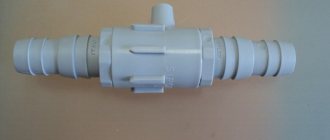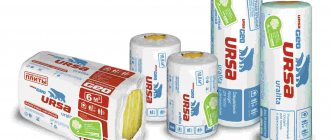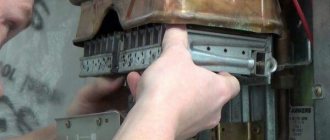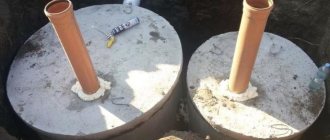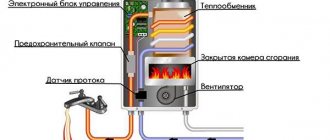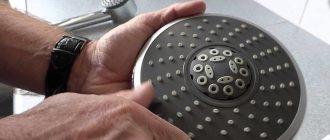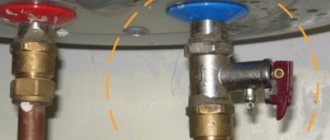Requirements for a standpipe
The production of outdoor speakers is based on state standard number 15150. The main requirements relate to the location of the device, and the number of consumers is also taken into account.
- A column is installed at the location of the water well. If there is no well, it is recommended to build it as close to the sidewalk as possible. The ideal place is a crossroads.
- Consumer coverage is carried out at the rate of one column per area with a radius of 1000 m.
- It is optimal if the street water intake is formed on sandy soils for easy drainage of water into the ground.
- An elevated installation location is better than a low-lying one.
- In winter, it is better to insulate the column, because the metal casing will not be able to protect the water from freezing.
- Installation is carried out on water supply networks in which the pressure does not drop below 1 atm.
All fulfilled requirements guarantee long-term and efficient operation of the device. In this case, the depth of the water pipes must be taken into account. Based on this parameter, the device model is selected.
Specifications
Water dispensers produced in Russia are strictly manufactured in accordance with GOST. Therefore, they have standard technical characteristics:
- operate at a water pressure within the water supply network of 0.1-0.6 MPa;
- the diameter of the pipe connecting the device to the water supply is 20 mm;
- outlet pipe diameter – 15 or 20 mm;
- vertical valve stroke – 16-18 mm;
- The weight of the device with a length of 1.25 m is 31 kg, the weight increase is 2.6 kg for every 25 cm of increase in the length of the device.
The speaker body is made of steel or cast iron and painted to prevent it from rusting. The device itself is a collapsible device, so it can be easily repaired. Manufacturers offer any parts and components as spare parts.
The best manufacturers
In Russia, manufacturers of standpipes are large factories that specialize in pipeline fittings or metalworking.
Korkinsky Mechanical Plant (Chelyabinsk) - produces water standpipes of the KV-4 type, the total length of which varies from 1.5 to 4.5 m, and the above-ground part is 1 m. The operating pressure is from 0.15 to 0.5 bar .
Among foreign manufacturers, the following most famous brands can be distinguished.
Fabryka armatur Jafar (Poland) – produces outdoor speakers with water separating properties. The body of the product is made of cast iron and painted with blue, red, green or black powder paint. The column can operate within a range of ±50°. The materials used to manufacture the column have anti-corrosion properties.
Design and principle of operation
The design of a street water pump includes a small number of parts. The main one is the ejector. With its help, the water supply is opened and closed:
- pipe riser located inside the housing;
- an ejector consisting of three parts: a neck, a socket and a receiver (sump);
- in the lower part of the device (receiver) there is a cylindrical mesh, the task of which is to filter the water entering the column;
- The speaker body is covered with a metal cover in which the lever is installed.
The column works as follows:
- when pressing the lever, the pipe riser is lowered;
- at the end of the latter there is a neck, which is a cylindrical object with a chamfer widened at the end;
- when the lever is pressed, the latter rests against the socket to prevent the riser from falling;
- at the end of the riser there is a valve, which is located in the lower part of the column - the settling tank (receiver);
- the valve closes or opens the receiver opening;
- when you press the lever, it goes down, opening the hole, that is, water moves;
- the lower end of the riser rests against a spring, which is located at the lowest point of the sump; it ensures the reverse motion of the entire structure;
- when the lever is released, the compressed spring expands, raises the riser, and the valve closes the hole in the upper part of the sump.
The design of the column is very simple, so it works effectively for many years. Most often, the spring that is constantly located in the water fails. It began to be made from tool steel, which is not afraid of contact with moisture.
Sometimes the riser gets clogged. It is replaced with a new one or cleaned by first disassembling the column.
The unique design of the standpipe is that there is never any water left inside the riser. Using an ejector, it enters the housing through a hole in the coupling. Therefore, outdoor devices can be operated at temperatures from -40C to +40C. This must be indicated in the product passport.
If the riser freezes in winter, the reason is a drop in water pressure in the water supply system or the temperature reading is below the permissible level.
Preparatory stage of pit construction
The top layer of soil is prone to crumbling, so the well is protected with a special structure - a pit, in other words, a hole one and a half by one and a half meters, the depth of which is no more than 2 meters. Boards are used to strengthen the walls, and they also line the floor. The strength of the floor depends on the thickness of the boards, so products no thinner than 5 cm are used. The pit is covered with a second flooring on top.
The holes for sand wells are small in size and are located at shallow depths, while the holes for artesian wells go several meters into the ground
Then prepare the holes in the following order:
- erecting a drilling rig;
- remove the top flooring;
- find the center point on the lower flooring;
- make a hole whose diameter coincides with the shoe and couplings;
- cut out a second hole - in the upper flooring.
The vertical precision created by the two guide holes guarantees high-quality drilling.
Types of water taps
Manufacturers offer two types of designs, which are labeled as KV and KVO. In terms of technical characteristics, both devices do not differ from each other. The main difference is the method of attaching the receiver to the device body.
In KV models, fastening is done with two bolts, which are passed through the ears. One is located on the speaker body, the second on the receiver. Gaskets are installed between the two units to ensure the tightness of the structure.
In KVO models, fastening is done using square flanges. One of them is welded to the body, the second to the receiver. This design uses four bolts.
Installation features
On the side of the receiver there is a pipe with a diameter of 20 mm with an external M20 pipe thread.
A pipe of the same diameter is connected to it, which is removed from the water supply circuit. The connection of the pipe to the water supply is electric welding. A valve must be installed between the column and the supply pipe. The connection is made using flanges or threads. The first option is simpler in terms of installation and maintenance. The purpose of the valve is to shut off the water supply and regulate its pressure.
Under the column inside the well, be sure to lay a solid foundation on which it will rest. To do this, pour a concrete pad or lay a ready-made reinforced concrete slab.
Before commissioning, the water dispenser is washed with an aqueous solution of bleach. In this way the device is disinfected. The well is closed with a cast-iron sewer hatch.
Operation and Maintenance
The speakers need to be serviced monthly. Check the ejector for leaks:
- a plug made of wood is driven into the drain pipe located in the upper part of the riser;
- press the lever;
- water fills the entire volume of the speaker body;
- the lever is released, and if the water has not increased in volume within 10-20 minutes, it means that the ejector fits tightly to the hole in the receiver;
- you need to pull out the plug, press the lever again and empty the column housing completely.
If the ejector works correctly, water in a 175 cm long water column will be removed from the housing in 5-6 minutes.
If it is necessary to carry out repair work, first of all it is necessary to close the valve, disconnecting the device itself from the water. Next, the cap with the lever is removed, then the riser, after which you can inspect and repair the parts of the ejector and sump. Often the mesh becomes clogged and simply needs to be replaced with a new one.
What is a driving well?
This type of well is extremely common in northern latitudes and has another, more popular name - the Abyssinian well. The popularity of the design is due to the desire of all people, even those living in remote regions, to have their own source of clean drinking water.
The advantages of this design are:
- Low (compared to other options) cost;
- Possibility to install a column/pump in any part of the yard;
- Durability of operation;
- Energy independence;
- Ease of implementation;
- High speed of work completion.
An example of a drilling well arrangement
Before starting to drive, it is necessary to carefully study the soil and understand how deep the aquifer lies. The easiest way to do this is to consult with neighbors who have already made a well for themselves. The discrepancy with their “readings” is usually insignificant – up to half a meter.
If it is not possible to clarify the information on site, the owner will have to contact a specialist who will determine the depth during the drilling process.
Of course, it is possible to do the work yourself, but the likelihood that titanic work will be done in vain is very high. With the help of special equipment, you can reach the aquifer within a few minutes. And if it is not found at a depth of 10 m, the work can be quickly curtailed or moved to another location.
Materials
To install a garden water pump, you need a source from which it will pump water. If there is no running water, you need to drill a well. First, the hardness of the soil and the depth of the aquifer are assessed. Based on this, a conclusion is made about which well to drill.
If the aquifer is deeper than 50 meters, deep drilling of an artesian well is assumed. It is impossible to carry out such drilling on your own. Deep drilling is carried out by specialists with the appropriate equipment:
- drill with drill rod;
- drilling rig;
- working winch;
- casing.
The Abyssinian well is the simplest water intake, which is drilled manually. To drill a well you need:
- thick-walled metal pipes 1.5-2 m long, with threads at the ends, 25 mm in diameter;
- 1m pipe with holes 8mm in diameter, staggered;
- steel cone with a diameter of 45 mm;
- steel connection couplings;
- sledgehammer for driving in pipes;
- fine metal mesh;
- check valve;
- manual pump (water column), electric pump.
The depth of the Abyssinian well is no more than 15 meters. How many meters of pipe, cut into pieces, are used when installing a well column. The diameter of the pipe is calculated based on which pump will be used to pump out water. If the pipe diameter is 5-7 cm, steel rods are used for driving.
Making a speaker yourself
Drilling a well on your own is not an easy procedure, so the owner must immediately foresee the possibility of attracting 1-2 people to help.
In order to quickly cope with the task, work must be performed in stages:
- Preparation. Before starting work, it is necessary to clean the surface from small debris and level it as much as possible. A rational approach to the location of the column is also mandatory - it should be based not where it is convenient, but in a place where the aquifer passes as close to the surface as possible.
- Digging a hole. For the convenience of carrying out further work in the chosen place, you need to dig a “pit” up to 1.5 m deep. The width of the depression should be approximately 2 m. To prevent the soil from falling back, it is advisable to strengthen the walls with wooden plates.
- Working with a drill. Which mechanism to prefer - manual or mechanical - depends on many factors. From about a depth of 2 m, sand and wet soil begin, complicating the work. Approximately every 15-20 cm, the drill must be removed and cleaned of the adhering mass, otherwise it may break under the weight of the soil.
- Equipment installation. A pipe is stretched to the bottom of the well, through which water will flow into the column located at the very top. In order to at least slightly protect the system from small debris, it is advisable to install a special filter in the pipe.
After drilling a well, you can install the column yourself.
Drilling a well and installing a column takes from 1 to 3 days. It is better to perform them during the sultry heat, when the water lies as deep as possible. And if you enlist the support of assistants, things will go much faster.
Drilling process sequence of actions
If you prepare the necessary equipment and follow the sequence of steps, there will be no questions about how to properly make a well. The finished drilling rig is equipped with a head and a mechanism in the form of a winch. The bar is passed down through both holes, if necessary, it is extended and the collar is secured. Usually two people rotate the gate, and a third person is needed to correct the position of the bar.
If the well is shallow, then only a drill column is used, directing it down strictly vertically. A tripod with a lift is necessary for deep wells
A mark is placed on the column, retreating 60-70 cm from the top flooring. Having lowered the column to the designated distance, it is removed back, removing the rock raised along with the drill. The cleaned column is immersed in the same way several times. Greater depth requires extension of the bar. To do this, another pipe is connected using a coupling.
Depending on the stability of the soil, the drilling method is chosen - with or without casing pipes. With stable, dense soil, you can drill the entire well without using casing pipes. Crumbling rocks indicate that after 2-3 meters a pipe equipped with a shoe should be installed. The diameter of the pipe is wider than the diameter of the couplings, so the pipe enters the shaft with difficulty. Sometimes, to place it there, they use a screw or a sledgehammer.
Products for laying water pipes are used as casing pipes - metal or polypropylene pipes of the required diameter for external work.
If rocks are crumbling, collapse should be avoided. For this purpose, the drill is not lowered too low - below the end of the casing by a certain distance. Usually it is equal to half the length of the drill. Thus, the process consists of alternating drilling and installation of casing pipes, which are built up as they go deeper.
How to drive a pipe under water yourself
Hammering is a technology that is used exclusively on soft, pliable soils. It is almost impossible to drive a pipe into dense black soil, because the original structure will certainly be damaged.
The driving technology looks like this:
- A small well is dug, no more than 1 m deep;
- Two strong metal clamps are attached to the bottom of the pipe;
- A blank is placed on the central part of the metal structure through which the cable will be pulled;
- A pipe is installed vertically into the well.
The work is performed by two people who periodically lift the workpiece by the cable and lower it at the highest point.
You can drive a pipe under water with your own hands if you carefully follow the step-by-step instructions
During such manipulations, mechanical stress is exerted on metal clamps that transmit force to the pipe itself. Under this influence, it gradually sinks into the ground.
The main thing in the work process is accuracy, because the pipe needs to be hammered, not pierced.
Advice and recommendations from experts
When planning to make a water well or well in your yard, you must first draw up an action plan and organize the work strictly according to it.
Experienced experts advise even those who have thoroughly studied the technology to remember a number of the simplest rules:
- Clogging is carried out for more than one year, so you should not skimp on materials;
- Those who are not confident in themselves should enlist the support of specialists or simply ask them for advice;
- Wells, pipes and columns require periodic cleaning;
- It is very important to properly preserve the system (even if unfinished) for the cold season.
The decision to drill a well yourself is completely justified from an economic point of view. Don’t be afraid of the work, because it doesn’t involve any pitfalls. Punching is carried out using a drill, which is simply screwed into the ground until the aquifer is found. Once one is discovered, you can safely install pipes and a water pumping system.
Do-it-yourself water supply in the country: the simplest installation methods
There is no need to convince anyone that running water in a dacha is necessary. This is already obvious. Therefore, we will immediately dwell in more detail on how to make a water supply system in a dacha with our own hands, taking into account its operation at different times of the year.
First of all, you need to choose a water source. The cheapest and easiest way to provide fresh water to your dacha is to build a well. It can have different depths. It all depends on the depth of groundwater. Basically, it does not exceed fifteen meters, and therefore the construction of a well costs minimally. However, such a structure provides small volumes of water (up to 200 liters per hour), and it also contains various impurities (nitrates, heavy metals, bacteria).
Less popular manual modifications
In addition to piston models, which have proven themselves well in factory and homemade versions, other devices are also used.
They are less productive, but interesting from the point of view of design and operating principle.
Image gallery
There are factory models that are not practical to make yourself. For example, equipment based on an impeller. Such devices are used in the industrial sector; they are not very convenient for the garden.
In addition, buying a compact metal device that looks like a can twister will cost no more than making it yourself.
None of the considered homemade pump designs suits you? Then we recommend that you look at more options for homemade products, the production of which we have considered.
Wells and wells: what you need to know
Well design diagram
A more acceptable option is to build a sand well, the depth of which, depending on the aquifer, can be from 15 to 30 meters.
Such a structure can produce approximately 1.5 cubic meters of water per hour, which is enough for a small house.
What is better, a well or a borehole?
Drilling a sand well is carried out using the auger method - the rock is extracted to the surface. This usually takes from 3 to 5 days. However, the sandy aquifer contains a lot of clay and sand, and therefore filtration equipment will be needed in this case.
The deeper the well, the more likely it is that there will be no unwanted impurities in the water.
The best way to supply water is an artesian well. The water rises from it under pressure. Such a well can produce about 10 cubic meters of water per hour. In this case, a casing made of metal pipes must be used. The service life of such a well is about fifty years.
Do-it-yourself summer plumbing
First, let's look at the installation of a water supply system at the dacha, which will be used only in the summer. This type of water supply is used for watering plants at the dacha, connecting a summer shower and for current household needs. It is not intended to be used in winter. Summer water supply at the dacha can be either permanent or collapsible.
The most common is water pipes (hoses) which lie directly on the ground. Such a water supply is made from simple rubber or silicone hoses connected to each other by adapters. Connection adapters are commercially available and are made of galvanized steel or plastic.
There are also special latches on sale on one side, which have “ruffs” where the hose is put on, and on the other side there is a convenient spring-loaded connector. These latches can be connected and separated in one motion. They are quite capable of providing a reliable joint. Note that when purchasing hoses, you need to buy rubber hoses with thick walls, which are reinforced with nylon fibers. Of course, plastic water supply at the dacha will cost less, but such hoses will last longer - at least 15 years.
Summer water supply at the dacha made of plastic pipes
For a permanent summer water supply, pipes must be laid in the ground, and water taps must be brought to the surface. In this case, it is enough to just cover the pipes a little with earth to avoid tripping over them and to protect them from theft.
The main disadvantage of a permanent summer water supply is the need to maintain a slope to the connection point - to the main line. A drain valve is placed at this lowest point in the water supply to drain water for the winter. Otherwise, the water may freeze and burst the pipes.
Winter country water supply
Now let's talk about more solid and capital schemes. Let's start with a description of the winter water supply. Winter does not mean that it can only be used in winter; it simply means that the water supply is carried out according to a permanent scheme and can be used at any time of the year.
An example of an autonomous winter water supply in a country house
To supply water from a well, it is better to use a submersible pump. Its power is selected depending on the depth from which water will be supplied. For a well up to ten meters deep, a small “stream” or “aquarius” is enough. If water is supplied from a well, you will have to buy a more powerful pump, which will cost much more.
Due to the fact that when installing a winter water supply, the pump must be connected to a voltage source, it is permissible to combine the cable and water supply in a single casing made of plastic sewer pipes. It will protect well from freezing and mechanical damage.
Laying water pipes made of plastic
To lay the water supply, you can use plastic pipes with soldered connections or special plastic fittings. For soldering connections, use a special electric soldering iron. It is not very expensive, and specialized stores often offer such soldering irons for rent. To install the pipeline, you will need a soldering iron for no more than a day. Connections on fittings are made with bare hands without a soldering iron. For an ordinary dacha, pipes with a diameter of 20 or 25 millimeters are quite suitable.
Pipe fittings and connections
When laying water pipes, pipes must be placed below the freezing level of the soil. The value of this value for each specific climate zone can be found in special reference books.
But often, in order not to dig too deep a trench, you can use one of the following methods:
Cover the pipe laid at a depth of 60 centimeters with a 20-30 centimeter layer of insulation made of foam chips, furnace slag, expanded clay, etc. The main condition is that the insulation does not absorb moisture well and is strong enough.
Insulate the pipeline with an insulation system consisting of special thermal insulation and a casing made of corrugated polyethylene. Using such a system, the depth of the trench can be made much smaller (about 30 centimeters).
Lay a heating cable that allows pipes to be laid on the surface. But you will have to pay a lot for electricity.
It should be taken into account that the trench should approach the house at a right angle, because it will be necessary to dig up the foundation, which is fraught with its settlement and the formation of cracks in the wall.
Connecting the pump to the water supply
To connect the pump to the water supply, it is necessary to build a pit next to the well, one meter deep and measuring 70x70 centimeters. The walls of the pit are lined with bricks or reinforced in another way, for example, with boards soaked in antiseptic. It would be better to fill the bottom of the pit with concrete or, as a last resort, fill it with crushed stone and compact it.
Connecting the pump to the water supply
A water pipe with a “ruff” for attaching the hose that comes from the pump, as well as an electrical wire, is brought into the pit and fixed. The function of the pit is that, if necessary, the pump can be easily disconnected and removed. The pit is insulated to prevent water from freezing in the pump hose.
Pump connection example
To connect the pump, install a waterproof socket or use a sealed contact connector, better known as a “male-female” connector. The main condition is that the pump can be safely connected and disconnected, even if the cable is energized.
Water taps
Water-folding ball valve
We have decided how to make a water supply system at the dacha. Now let's take a closer look at water folding devices. For outdoor use, bronze or cast iron valves, as well as ordinary taps with axle boxes, are quite suitable.
Mechanisms for self-construction of wells
Usually, special drilling equipment is used to construct a well, so a completely logical question arises: how to drill a well in a country house without using it? It turns out that there is a simple manual mechanism consisting of a drilling rig and a column suspended from it. Let's take a closer look at the individual pieces of equipment.
The base is a tower resembling a tripod. The material for the supports is either metal pipes or logs connected at the top with a pin. The drill column lifting block is also located there. The two legs of the tower are connected by a winch (gate).
The design of drilling equipment may vary. In some cases, if the impermeable layer lies close to the surface of the earth, a hand drill is sufficient
The drilling column is the main functional element. It consists of several three-meter rods connected by couplings. Sometimes a length of one and a half meters is enough. It is the column that is immersed in the ground, and its length is adjusted using rods. Replacement of special equipment are water pipes equipped with steel couplings.
Drilling heads must be selected depending on the nature of the soil. Here are the most commonly used: 1 - “spoon”, 2 - “snake”, 3 - “chisel”, 4 - “bailer”
The impact or soil-cutting element is the drill head. It is screwed onto the column using a threaded adapter. As the head is lowered into the soil, soil fills the drill cavities. For different types of rocks, different attachments are used: a “spoon” is suitable for soft soil, a “coil” for dense soil, and a “chisel” for hard rocks. Use a bailer to lift the loosened soil up.
To prevent the walls of the well from crumbling, casing pipes are used - as a rule, these are ordinary plastic plumbing products, lightweight and easy to install. The bottom of the pipe is a kind of shoe, with a smooth or jagged edge at the bottom.
There are two main types of casing shoes: a – toothed (mill), b – smooth. Cutting area: 1 – teeth, 2 – smooth edge
Thus, the construction of a well takes place using special equipment, some of which can be purchased at the store, some of which you can make yourself.
Water stand near the house
A standpipe is especially needed for use in populated areas where there is a lack of water supplied from the centralized water supply.
It is impossible to say that the device works perfectly, but it performs its functions perfectly, at least in the warm season.
The design of the water column is simple. It is installed in a well or on the ground and consists of:
- valve;
- ejector;
- pipes for lifting water;
- columns;
- lever mounted to the column (these two elements are on the surface).
Types of devices for pumping water
Physical force alone used to lift water upward is not enough, since the process becomes difficult and labor-intensive.
Therefore, mankind has long ago invented many devices that facilitate the rise of liquid from a well or natural reservoir to the surface. All devices are united by a common operating principle, which is based on the interaction of the valve system.
There are many varieties of hand pumps, but four main types can be distinguished:
- piston;
- rod deep (varieties of piston);
- winged;
- membrane
For manufacturing at home, they usually choose the first type if it is necessary to service a well of shallow depth (3-6 m), or the second if it is necessary to lift water from a well from a depth of 10-12 m.
These models are considered to be the most productive, easy to assemble and install, and reliable. The rest have significant shortcomings, the biggest of which is considered to be insufficient productivity.
It is piston devices that have occupied the main niche among factory manual equipment; they are popular among home craftsmen.
Image gallery
The advantage of piston column pumps is their ease of assembly and installation. All the parts necessary for the manufacture of the body and dynamic parts can be found on the farm or purchased in addition.
And to connect the elements into a single device, home tools are usually enough: a drill, a circular saw, a hacksaw, pliers, and keys. If you need a welding machine, you can rent it or borrow it from your neighbors.
Disadvantages of standpipes
Despite the obvious need for use when the water supply is poor, this equipment also has disadvantages:
- there must be a sufficiently high pressure in the water supply network, otherwise the performance of the dispenser is noticeably reduced, in particular, when drawing water from a centralized network;
- freezing of water in winter, especially at low pressure;
The main functions assigned to the column: water intake and supply. Therefore, it is better to choose high-quality equipment for installing the column; moreover, this will increase the chances of maintaining the integrity of the gasket for collecting exclusively purified water from the water supply.
Water taps are used not only in populated areas, but also on construction sites and in suburban industrial establishments.
Conclusion
Modern decorative water taps are not only a decoration for a personal plot, but also an effective opportunity to provide water to a home, garden, vegetable garden, etc. Now that you know what the design of the device is and what the instructions for its operation are, you can make the right decision about installing such equipment near your dacha.
Still have questions that require clarification? More useful information can be found by watching the video in this article.
Did you like the article? Subscribe to our Yandex.Zen channel
Basic requirements for a water standpipe
In order for the installation of the water dispenser to be correct and the device to work for a long time, the following requirements must be met:
- It is better to install it near an intersection or near the sidewalk (however, it all depends on the location of the well. If installation takes place in a well, the location is determined; if not, it is recommended to do it as close to the sidewalk as possible);
- installation of a water standpipe should be carried out on the basis that the service radius of the device should not be more than a thousand meters;
- To avoid problems with drainage, it is better to install it at an elevated location (but not at a significant height). The main thing is to maintain natural drainage;
- It is not recommended to install on a dead-end line if it is carried out in the ground.
In general, standpipes are used over a wide temperature range: from -40 degrees to +40 degrees.
application features and main characteristics of hydrants
A water standpipe is a mechanical equipment designed for supplying and withdrawing water from a centralized water supply main.
As has already been reported, the equipment is used to provide water to populated areas or individual construction sites that are not equipped with a water supply.
Let's look at the recommendations and basic requirements that you should take into account when installing and operating standpipes yourself:
- The classic location for a water standpipe is now considered to be an intersection or a roadside part of the sidewalk.
- In accordance with the requirements of national standards, the service radius of equipment should be no more than 100 m.
- When choosing a location for these installations, it is preferable to use areas on a hill, since in this case it will be easy to ensure natural drainage of wastewater.
- Installation of the column can be carried out on a street water supply line, on a looped line, or on branches from the main line.
- Due to the high possibility of freezing, installation of equipment on a dead-end line is advisable only if a constant and impressive water flow is expected.
Structural highlights
The design of the device consists of the following elements:
- valve;
- ejector;
- water riser pipe;
- housing with a lever movable in a vertical plane.
Thanks to its operational features, the design of the water column is durable and strong.
- The column body is a vertically located pipe with an average cross-sectional diameter of 90 mm. The body is made of low-carbon steels, which perfectly withstand sudden temperature changes, mechanical loads, etc. The surface of the case may be painted with simple paints, the price of which is low, but for long-term operation it is better to choose those devices whose case is coated with powder paint.
- The water-lifting pipe (rod) is installed in the housing and is responsible for the water supply. In order to achieve optimal water supply intensity, the nominal diameter of the water pipe has a diameter of at least 15 mm. Once the water supply is stopped, the remaining water is drained to prevent freezing in winter.
- An ejector is a type of jet pump installed in the column body to pump out residual water from the rod.
- The valve is part of the water intake column in which the ejector is installed. The design of the valve is dismountable, as a result of which, if necessary, it is possible to replace worn out seals. The valve, like the entire column body, is made of strong and durable low-carbon steel.
Operational defects of equipment
If anyone with a simple installation tool can figure out how to connect a gas water heater to a water supply system, then with the water heaters discussed in this article everything is not so easy.
Let's look at the most pressing operational shortcomings of hydrants and try to find ways to eliminate them:
- Unsatisfactory operation of equipment at low pressure with a high risk of freezing in winter. The reason for this phenomenon is contained in the limited lower limit of pressure in the water supply system.
- The ingress of surface groundwater into the dispenser spout through the ejector is a significant drawback that has a very bad effect on the quality of water purchased by the consumer. The reason for the penetration of groundwater is an incorrectly installed gasket.
- The need for enormous reinforcement when opening the shut-off valve. The circumstance is contained in the resistance of the return spring and in the water pressure specifically on the valve plate. Nothing can be done about this defect, since these are structural features of the equipment, which cannot be changed.
- The column freezes in winter, regardless of the presence of an ejector. The cause of freezing is the remaining small volume of water in the rod and in the valve.
How to make sure that water in small quantities does not remain in the device and does not freeze? First of all, you can try to configure the ejector correctly. This is not easy to do, since the pressure in the water supply system is not constant.
To completely get rid of residual water in the boom, it is possible to drill a drain hole or loosen the connecting pipe flange, creating a natural drain. Both methods are difficult to implement, and besides this, they contradict the instructions for using the device. Based on this, it is advisable to entrust such work to experts.
